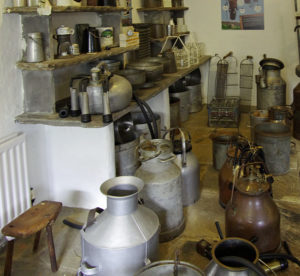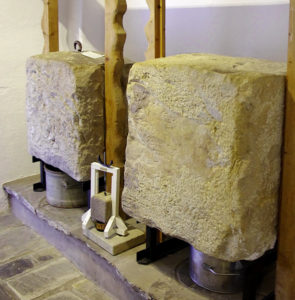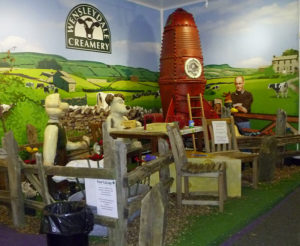Cheese making in Wensledale began with the Cistercian monks in the C12th. After the dissolution of the monasteries the recipe was passed to farmer’s wives who continued to make the cheese in farmhouse kitchens. Cheese making was traditionally a summer activity and the quality and flavour of he cheese varied from farm to farm.
In 1897 the first Creamery was built in Hawes by Edward Chapman, a local corn and provisions merchant, using locally produced milk. The Creamery was sold to the Milk Marketing Board in 1966 and became part of Dairy Crest. They closed the Creamery in 1992, when production was transferred to Lancashire. It was bought by four of the managers with the help of a local business man, reflecting the strong community spirt in support of Hawes. Since then the business has gone from strength to strength. A new factory was opened in Kirkby Malzead near Ripon and a new dairy was built at Hawes in 2014.
Today, the Creamery is a major employer in Hawes with 300 staff and a turnover of £25 million. Milk is bought in from 45 local farms every day. Cheese is still produced traditionally in the massive 10,000 litre tanks which will make about 1tonne of cheese, which is packed by hand into moulds. The process can be watched from the viewing room windows.
As well as traditional Wensleydale, the Creamery also produces a range of speciality cheeses like the ever popular Wensleydale and cranberries which is top seller in the USA. All the different varieties including apricot, ginger, hot and spicy and many others are available for sale in their excellent “shop”:https://www.wensleydale.co.uk/shop/ or on line.
It is possible to book a tour of the Creamery which includes a cheese making “demonstration”:https://www.wensleydale.co.uk/visit/yorkshire-wensleydale-cheese-experience/ , when visitors can watch the whole process of turning 8pints of milk into a 500g truckle of cheese in 40 minutes.
The milk is pasteurised on arrival at the Creamery by heating to 72˚ for 15minutes and then cooled to body temperature. This kills off any bacteria or other micro-organisms in the milk. A special starter culture of ‘good’ bacteria are added to the milk. This is a specially produced strain and unique to the Creamery and is stirred in.
The bacteria feed on the lactose converting it into lactic acid and giving the cheese its traditional flavour and also helps to preserve it. This thickens the milk which is cut to break it up.
Next rennet is added to the milk. This traditionally came from the stomach of calves but the Creamery now uses vegetarian rennet made from thistles. (We were told if rennet was not available the farmer’s wife would boil down a bucket of slugs and the extract could be used instead…) The milk is allowed to set to form a semi-solid junket.
This is cut by knives to release the curds from the whey, and to break the curd down into small pieces the size of baked beans. Boiling water is added to the mix. This ‘bakes the outside’ of the curds helping to get rid of moisture. Commercially this is done by passing steam round the jacket of the vat to raise the temperature by a few degrees. The curds are then released onto working tables and are continually cut to encourage the whey to drain off. The finished texture of the cheese is determined by how well the curd is worked at this stage. Samples are checked for quality.
About 85% of the original milk is whey. The Creamery skims off the fat which is used for butter making and the rest is sold locally as pig food. The remaining curds look a bit like scrambled egg.
Once the correct acidity level has been reached, salt is now stirred into the curds. This reduces the activity of the starter culture as well as helping to get rid of any whey. It also acts as a preservative and adds flavour to the cheese. Commercially the curd would be passed through a cheese mill which shreds it into small pieces. Any flavourings, like cranberries, are added now. The curds are packed into the cheese moulds by hand and weighed to check the finished cheese will be the correct weight.
The moulds are then pressed to expel any remaining weigh. This takes between 24-72 hours depending on the size of mould used.
The cheese is then removed from the mould and bandaged in muslin cloth before being placed in the drying room for another 24-72 hours. The cheeses are turned regularly to ensure even drying. A natural rind forms round the outside of the cheese. Cheeses are wrapped in wax or polythene before being matured in a cool dry room. Most are ready to sell after eight weeks, but mature cheese can take up to nine months.
To make blue cheese, wires are pushed through the cheese and it is left to blue naturally with Penicillium moulds found in the air.
The Creamery also has a small museum of old stone and metal cheese presses as well as old milking machinery.
And finally we mustn’t forget Wallace and Gromit, Wensleydale Cheese’s greatest fans, who have pride of place in the exhibition centre.
This makes a fascinating visit. Don’t miss the “shop”:https://www.wensleydale.co.uk/shop/ selling everything cheesy and there is also a “restaurant.”:https://www.wensleydale.co.uk/visit/places-to-eat/
Plan a visit for the morning when cheese making is taking place and there is plenty of activity to watch. All my pictures are “here.”:http://wasleys.org.uk/eleanor/presocialhistory/socialhistory/industrial/creamery/index.html
There is plenty of parking at the creamery which is on the southern edge of Hawes. The post code is DL8 3RN and the grid reference is SD 871896.










